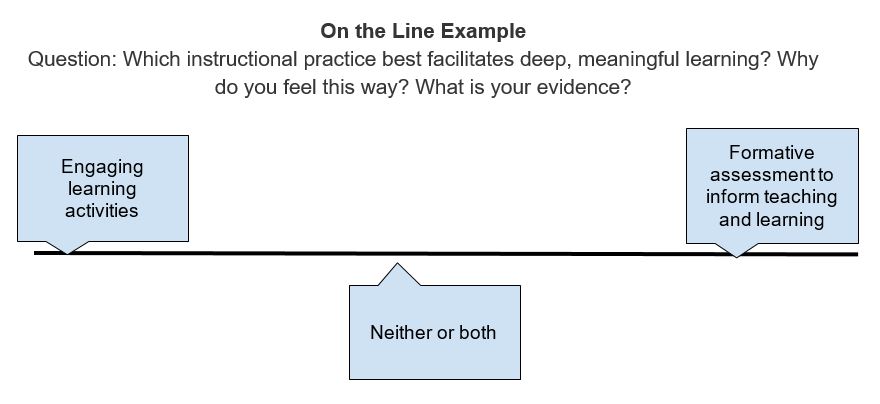
From Traditional to Cyber CATs: Different Breeds for Different Needs
Research has shown that using formative assessment to inform instruction is one of the most important components of good teaching (Rosenshine, 2012). While many teachers
Research has shown that using formative assessment to inform instruction is one of the most important components of good teaching (Rosenshine, 2012). While many teachers rely solely on questioning and discussion techniques to gauge a class’s comprehension and learning, formative assessment strategies are needed to engage and assess learners individually. Classroom assessment techniques (CATs) facilitate more meaningful learning by providing opportunities for students to self-reflect on their learning while instructors collect information on what and to what degree students learned (Angelo & Cross, 1993). Here are three fresh takes on CATs and how they can be used in online courses.
Classroom instructors have long known that one of the best ways to assess students’ understanding of content is to get them talking. But typical Q&A formats can be routine and boring. On the line is a technique that overcomes this problem. First, the teacher constructs a series of opposing statements about a topic related to class learning. These statements should be designed to spark debate and deep thinking, and students must formulate their agreement with or other opinion on the matter using information from the class period or about the topic discussed. The teacher then asks students to place themselves, according to their preference, on an imaginary line that spans the length of a classroom. In the teaching field, for example, the instructor could ask, “Which is more important to driving student learning: engaging activities or formative assessment?” The answer, of course, is both, but allowing students to choose one side helps to facilitate deep thinking and rationalization. Alternately, students who do not have a strong opinion on the matter can put themselves in the neutral, middle zone of the line. When we introduce this activity, we start out with sample statements, such as “Which type of snack do you prefer: sweet or salty?” We then gradually work up to more difficult topics that involve basic understandings of what we’ve discussed in class.

While this is a great strategy to use during face-to-face (F2F) classes, how can it be done online? One answer is Flipgrid. Flipgrid hosts social media–inspired video discussion boards. In online classes, students are traditionally required to post written questions or responses (or both) to questions on a digital discussion board. Flipgrid utilizes the ease of taking videos with smartphones and other devices. Students access the grid board, view the prompt, and then record a brief oral response that is posted. This allows the students to both state where they stand and why. The video can be rerecorded and saved as many times as the student wishes before being posted. Students can then view others’ videos and record responses to them. The video format encourages engagement with the topic.
Interactive CATs are forms of assessment that allow students to actively engage with the content during rather than after a learning session. This can take many forms, such as students’ holding up index cards to demonstrate either-or relationships; drawing or illustrating concept maps to show patterns and relationships; writing responses to questions or generating examples and nonexamples on whiteboards and holding them up for the instructor to see; and completing interactive, multiple-choice quizzes using a game format. The main point of these types of CATs is to facilitate active learning through a lesson while also letting the instructor check for the entire class’s understanding before proceeding with a lesson.
Nearpod is a tool that can encompass many features of interactive CATs in one and can be used in both F2F and online settings. Nearpod is a web application that allows instructors to create teaching presentations interspersed with quizzes, open-ended responses, drawing boards, drag-and-drop items, polls, and collaborative posts that students submit throughout the presentation. Not only do these activities offer students opportunities to engage with the content and in learning, they also provide instructors with formative assessment data that can be used to give feedback. In a F2F setting, instructors can use student response apps to collect real-time examples of concepts; display exemplars of student work to the class; and quickly clarify, correct, and enhance understanding of the content where student responses indicate a lack of understanding. In an online setting, students can use Nearpod in the student-paced mode, in which they asynchronously access the material, including the interactions, on their own time and even receive instant feedback on answers, such as what the correct response is and why.
Exit tickets are a great way to facilitate reflection about content at the end of a class period. One of our favorite exit ticket ideas is a connected, reflective process known as teaching synectics. In this model, students learn to use a new idea or course concept and connect it metaphorically with the visual image of a well-known idea or topic. For instance, in a pedagogy class for preservice teachers, students are taught about differentiation and meeting individual student learning needs. They are given a variety of images and directed to reflect on what they’ve learned about the educational process connected to the image by verbalizing or writing their observations on the back of the image, as in the example below:

No two people have the same exact physical or emotional needs. This idea is no different for students in a classroom. Because every child is unique, they will also have their own set of needs in relation to learning, behavior and discipline, and even their emotions. No two paint brushes are the same. Some brushes have stains from past projects they worked on. Others may still have old paint on their bristles. New paint brushes have straight bristles with no spots on them. Many students come into a classroom well rested, fed, and ready to work. Unfortunately, not every student has this story. Some students have a harder home life and come into the classroom with scars from their past. Other students behave poorly because they’ve never been taught otherwise. A teacher must enter their classroom knowing that some students may need more instruction, others more structure, and some will simply need more encouragement. Similarly, no two paint brushes create the same stroke. An artist will learn this and use each brush how it will be most effective in their painting. When looking at brushes one on one, it can be seen that each has its own purpose. Though some are of similar size, or of similar materials, or even similar shape, each is used to create a specific line. People may share qualities, personality traits, or physical characteristics, but each will have aspects of their person that makes them different. Teachers must pay attention to their students’ needs and figure out how to make the classroom an environment that will foster learning in each student, much like how an artist must use their brushes how they are best suited to complete a painting. One teaching style will not effectively convey every concept to every student. Because of this, teachers must be aware of how their students learn and their individual needs. An artist requires many different paint brushes to make a single painting. Without the variety, the painting would not be as detailed or sophisticated. Without each student, the class would lose potential to be a positive learning environment. The differences in each student allows others to hear new ideas, meet a wider variety of people, and gain social skills.
—Student example, used with permission
Seesaw is an app that allows students to create and submit a variety of types of content, such as videos, images, drawings, documents, and portfolios of objects. It is our favorite way to convert exit tickets, teaching synectics, and other reflections to online environments through the journal feature. Students are given a reflection prompt related to course content and reply to this prompt in Seesaw. They can write a reflection, include a link to a website or article, post or annotate a picture, or record an audio or video reflection.
This tool lends itself to easily converting the teaching synectics exit ticket because it allows for creativity and variety in the reflection formats. To us, the absolute best feature of Seesaw is that when a student posts a reflection in the class journal, the instructor can provide immediate feedback by typing or recording an audio comment. This facilitates classroom assessment as a formative tool to further true learning.
CATs are important hallmarks of the teaching and learning process. By incorporating innovative and creative ways of assessing students’ understanding and engaging them with the content, instructors can better facilitate deep reflection on new learning. Assessment is just as important in online environments as in traditional ones, and emerging technology can assist instructors in designing these engaging experiences for students.
Angelo, T., & Cross, P. K. (1993). Classroom assessment techniques: A handbook for college teachers (2nd ed.). San Francisco, CA: Jossey-Bass.
Rosenshine, B. (2012). Principles of instruction: Research based strategies that all teachers should know. American Educator, 36(1), 12.
Amanda Hurlbut, PhD, is an assistant professor and Karen Dunlap, EdD, is a professor at Texas Woman’s University.